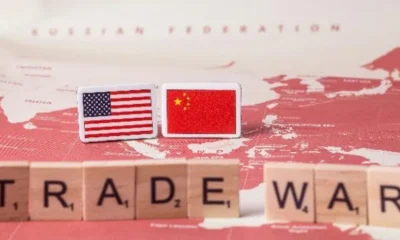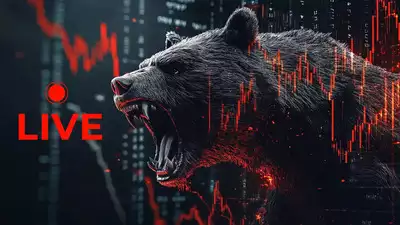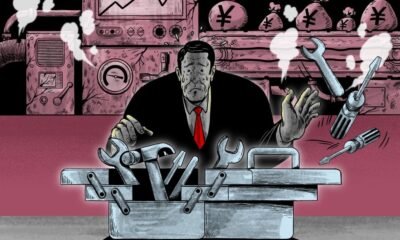Published
9 months agoon

As Donald Trump prepares for a second term in the White House, the global financial markets are already bracing for waves of uncertainty. The ripple effects of his trade policies are set to impact stocks, bonds, gold, interest rates, and oil prices worldwide, including in India.
Volatility on the Horizon
The market volatility we’ve witnessed recently is expected to persist, fueled by speculation about Trump’s trade strategies. The focus is squarely on the potential global economic consequences of higher tariffs, which could trigger inflationary pressures and disrupt trade flows.
What Could Trump’s policies mean for United States Economy?

What Could Trump Mean for Bond Markets?
Inflation and Yields – Bond markets have been rattled by fears of inflation due to Trump’s proposed tariffs, pushing up yields on government debt. Concerns about the administration’s borrowing plans, driven by Trump’s tax cut proposals, are also adding to investor anxiety.
What’s Next for Bond Prices?
If Trump’s tariffs turn out to be less severe and inflationary pressures are lower than anticipated, bond prices could stabilize and recover. For now, however, bond investors are likely to remain cautious and vigilant.
What’s Next for Oil Prices Under Trump 2.0?
With Donald Trump’s return to the White House, his “America First” approach is likely to heavily influence energy policy. Here’s how his plans could shape the future of oil prices – Trump’s administration is expected to double down on energy independence, continuing the trend of increased drilling permits seen during the Biden era. He has pledged to accelerate fossil fuel production while rolling back greener policies implemented under Biden’s Inflation Reduction Act.
If the US ramps up oil production, global supplies could increase, theoretically helping to stabilize or lower prices. However, this is unlikely to happen immediately, as energy companies may remain cautious about overproducing to maintain profitability.
Trump has also promised to end the war in Ukraine. While this goal appears ambitious in the short term, a resolution could ease market supply concerns, especially if sanctions on Russian oil are lifted. This would likely have a calming effect on global energy prices.

Insights from Nicolai Tangen, CEO of Norges Bank Investment Management In Perspective to India
As CEO of the world’s largest sovereign wealth fund, overseeing $1.7 trillion in assets, Nicolai Tangen offers valuable insights into global markets.
Tangen stated that nearly a third of the fund’s assets are in Europe, but with Europe’s slowing growth, diversification into the US, Asia, and India has increased. India now accounts for 1.8% of the fund’s investments, with over $30 billion invested—double the amount from five to eight years ago.
Tangen also spoke about India’s thriving democracy, entrepreneurial spirit, and strong leadership as driving factors behind its growth, noting that India’s robust IPO market, the country continues to be a critical part of the fund’s diversified portfolio.
Supply Chain Diversification from China, India
The global shift to diversify supply chains away from China is no longer just a talking point—it’s a reality. Companies across the US and Europe are actively working to de-risk their operations, and India has emerged as a significant beneficiary of this trend. Diversifying supply chains makes strategic sense for businesses looking to reduce over-reliance on a single geography. India’s increasing role in global supply chains illustrates its potential as an alternative to China, a trend that is likely to gain momentum in the years ahead.
However, he also shared some concerns about India.
While India is well-positioned to attract more supply chain activity, there is a valid concern – valuation risks.
India’s equity markets have been notably strong, often outperforming global peers; however, this raises questions about whether valuations are overheating. Investors and companies alike must tread cautiously to avoid potential pitfalls, he stated.
The Last Bit
The rise of dominant leaders and geopolitical tensions between blocs like the US and China adds to the uncertainty. While this bifurcation of the world economy reshapes trade, it also intensifies the risks tied to global commerce.
Coming to India, despite its strong position in global supply chain diversification, India faces its challenges. With Nifty earnings growth for FY25 projected to be the slowest since COVID, India’s growth story may face temporary hurdles.
Indian markets are not immune to the global tremors. A stronger dollar could make oil—India’s largest import—more expensive, pressuring inflation and the fiscal deficit. Meanwhile, any shifts in US trade policies could disrupt supply chains, impacting export-driven sectors.
As the world faces the uncertainties of Trump 2.0, the key for investors will be to stay vigilant, diversify portfolios, and closely monitor global developments. The road ahead promises to be turbulent, with opportunities and risks unfolding in equal measure.


Taiwan’s ‘Historic’ TSMC Deal, A Win Or The End Of Its ‘Silicon Shield’ As China Threatens? A Jittery Taiwan Watches Trump’s Moves On Ukraine, Wondering, Could We Be Next?


A Trade War That Just Won’t Quit. As Trump’s Tariffs Hit, China Stays The Course, For Xi’s Its Business As Usual Strategy


Indian Stock Market In Turmoil. Investors In Panic Mode, Is This A Temporary Correction Or The Start Of A Bear Market?


America And China’s Thirst For Gold In 2025 Is Draining Other Countries’ Reserves; Here’s Why?


China To Cut Inflation Outlook To 20-Year Low, Eyes Fresh Stimulus At ‘Two Sessions’ To Boost Economy


Shakeup In The Auto Sector. Mercedes-Benz 15% Job Cuts, Nissan CEO Exit, And Germany’s Make-Or-Break Year
